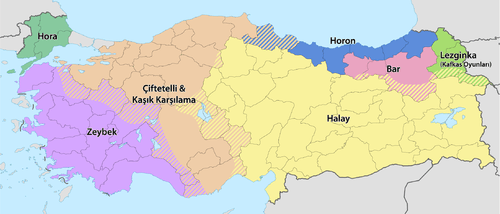Halay


Halay[a] is a regional category of folk dance styles in central and southeastern Anatolia.[1] The music accompanying the dance is the zurna and davul.[1] It begins slow and speeds up.[1]
Halay is traditionally played during wedding on the zurna, supported by a davul, but in the recent years, electronic instruments have started to replace them. Typically, Halay dancers form a circle or a line, while holding each other with the little finger or shoulder to shoulder or even hand to hand with the last and first player holding a piece of cloth. It is a national dance in Turkey and Azerbaijan. In Azerbaijani, yal means "row, line of chain"; the dancers stand in one line or two rows and sometimes in several rows.
The Ohuokhai is a simultaneous round dance and song. Dancers form a circle and dance, arm in arm, hand in hand, with the left foor put forward, while making rhythmical, graceful movements with their bodies, legs, feet and arms. A lead singer improvises the lyrics and the other dancers repeat them. This Ohuokhai leader has a special talent not only for singing but also, what is more important, for poetic improvisation. There song leaders compete at the national Yhyakh festival for the best poetic expression, best song and biggest circle.
See also
- Elazığ dik halay
- Kurdish dance, an Kurdish folk dance
- Attan, an Afghan or Pashtun folk dance
- Tamzara, an Anatolian folk dance
- Dabke, a Syrian-Lebanese folk dance
- Khigga, an Assyrian folk dance
- Kolo, a South Slavic folk dance
- Faroese dance, a northern European folk dance
Annotations
References
- 1 2 3 Jan Laurens Hartong (2006). Musical Terms Worldwide: A Companion for the Musical Explorer. Semar Publishers Srl. pp. 132–. ISBN 978-88-7778-090-4.
- ↑ Sevan Nişanyan, Sözlerin Soyağacı: Çağdaş Türkçenin Etimolojik Sözlüğü (the family tree of words: an etymological dictionary of contemporary Turkish), Istanbul, 2007